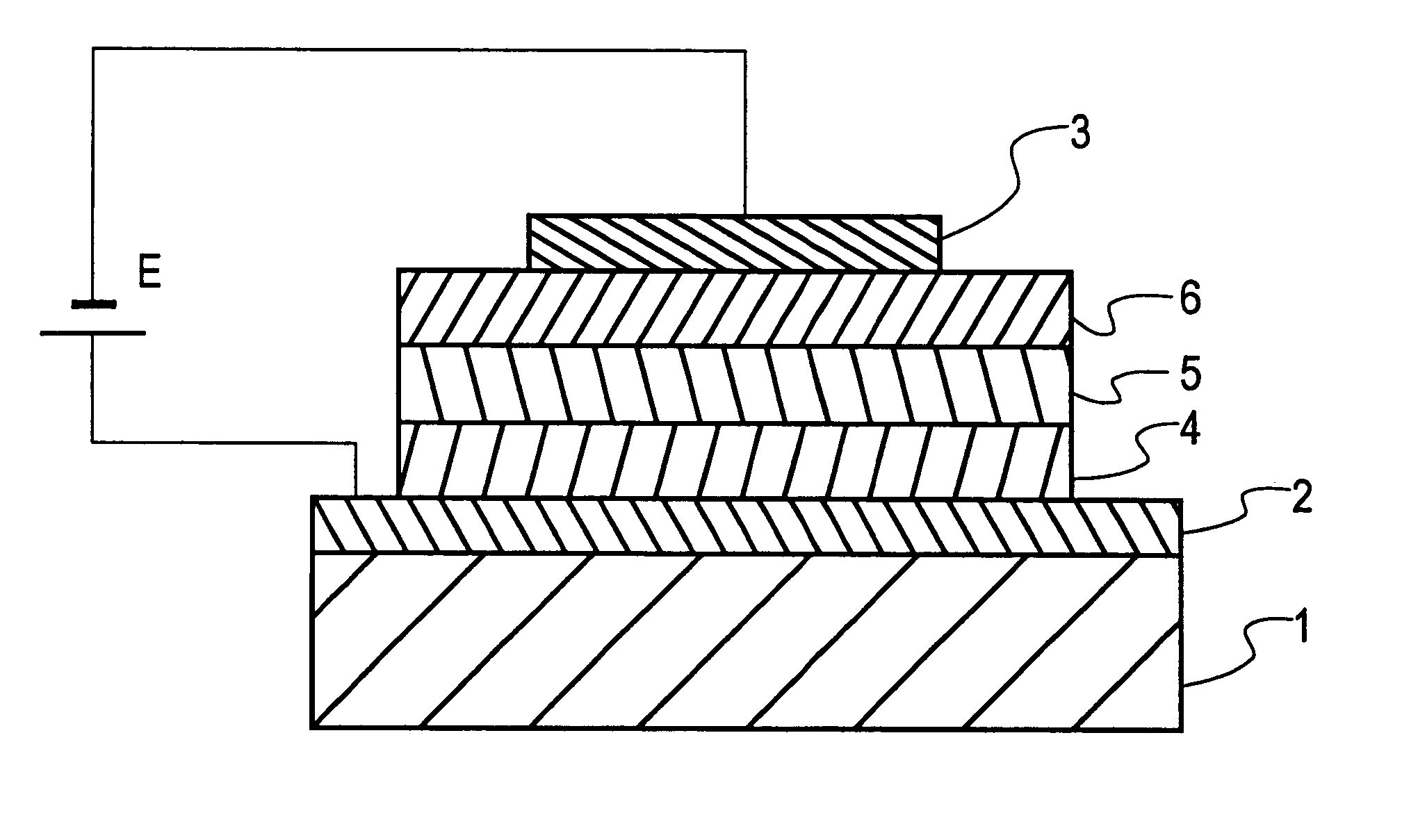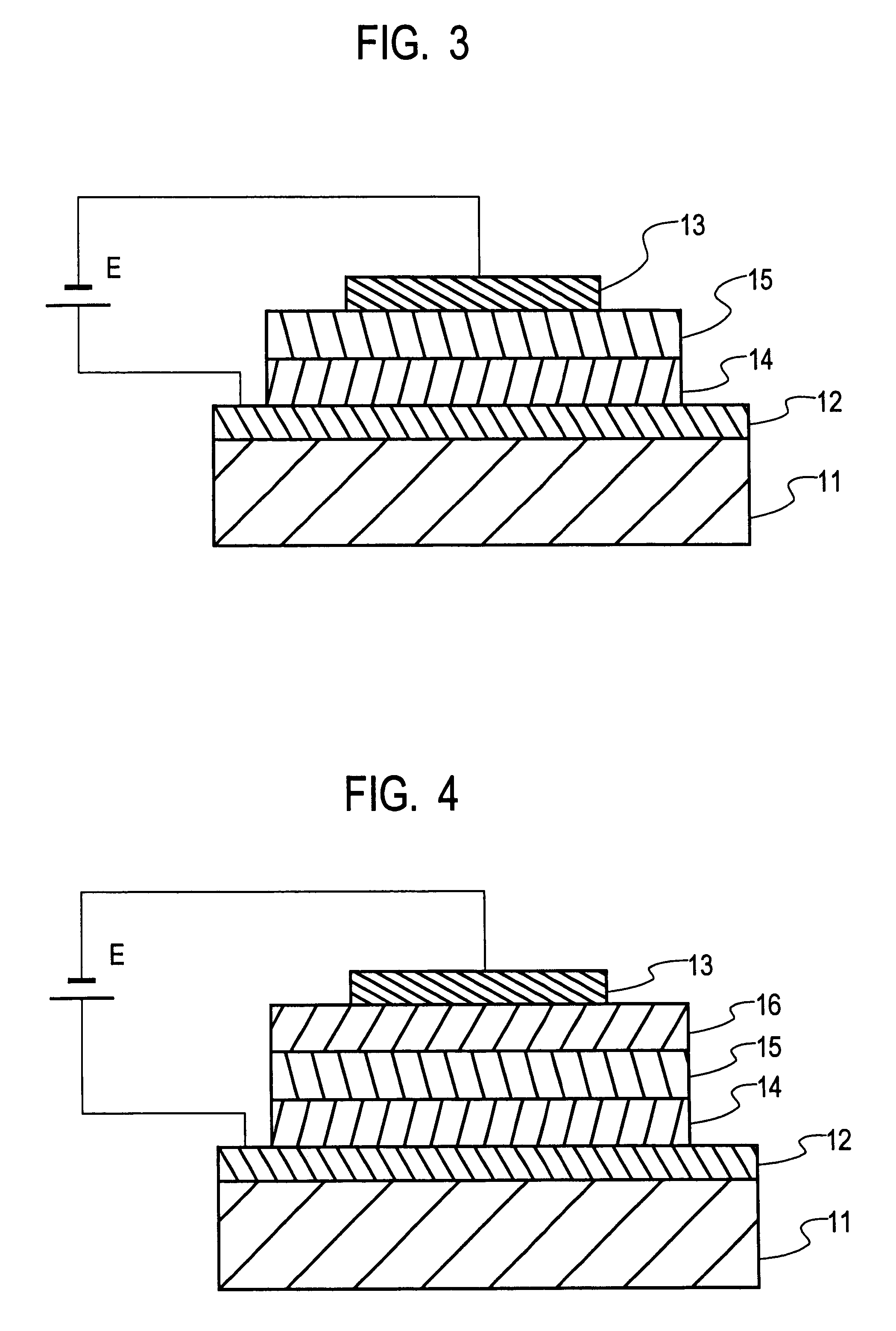Organic electroluminescent device
a technology of electroluminescent devices and organic el, which is applied in the direction of discharge tubes/lamp details, luminescent screens of discharge tubes, natural mineral layered products, etc., can solve the problems of low reliability of devices, oxidation resistance, and inability to withstand oxidation
- Summary
- Abstract
- Description
- Claims
- Application Information
AI Technical Summary
Benefits of technology
Problems solved by technology
Method used
Image
Examples
first embodiment
As typically shown in FIG. 1, one embodiment of the organic EL device of the invention comprises, in order from a substrate 1, a hole injecting electrode 2, a hole injecting and transporting layer 4, a light emitting layer 5, an inorganic insulating electron injecting and transporting layer 6 and a cathode 3 which are laminated together on the substrate 1. Another embodiment of the organic EL device of the invention is reversed in multilayer arrangement to the invention (the hole injecting electrode is opposite to the substrate side); it comprises, in order from a substrate 1, a cathode 3, an inorganic insulating electron injecting and transporting layer 6, a light emitting layer 5, a hole injecting and transporting layer 4 and a hole injecting electrode 2 which are laminated together on the substrate 1, as shown in FIG. 2. The reversed multilayer arrangement can prevent damage to the organic layer due to ashing during the formation of the inorganic insulating electron injecting lay...
example 1
A 7059 substrate (made by Corning) used as a glass substrate was scrubbed with neutral detergent. Then, the substrate was fixed to a substrate holder in a sputtering system, where an ITO hole injecting electrode layer was formed by a DC magnetron sputtering process using an ITO oxide target.
The substrate with the ITO film formed on it was ultrasonically washed with neutral detergent, acetone, and ethanol, and then pulled up from boiling ethanol, followed by drying. The substrate was subsequently cleaned on its surface with UV / O.sub.3. Then, the substrate was fixed to the substrate holder in a vacuum evaporation system, which was evacuated to a vacuum of 1.times.10.sup.-4 Pa or lower.
Then, polythiophene was deposited by evaporation at a deposition rate of 0.1 nm / sec. to a thickness of 10 nm thereby forming a hole injecting layer, and TPD was deposited by evaporation at a deposition rate of 0.1 nm / sec. to a thickness of 20 nm thereby forming a hole transporting layer.
With the vacuum k...
example 2
Experiments were carried out as in Example 1 with the exception that the main component, subordinate component and stabilizer in the inorganic insulating electron injecting and transporting layer were changed from SrO to MgO, CaO or an oxide mixture thereof, from Li.sub.2 O to K.sub.2 O, Rb.sub.2 O, K.sub.2 O, Na.sub.2 O, Cs.sub.2 O or an oxide mixture thereof, and from SiO.sub.2 to GeO.sub.2 or an SiO.sub.2 and GeO.sub.2 oxide mixture. The obtained results were much the same as Example 1. The same was also true of when the cathode constituting material was changed from Al to Ag, In, Ti, Cu, Au, Mo, W, Pt, Pd, Ni or an alloy thereof.
PUM
| Property | Measurement | Unit |
|---|---|---|
| thickness | aaaaa | aaaaa |
| mol % | aaaaa | aaaaa |
| thickness | aaaaa | aaaaa |
Abstract
Description
Claims
Application Information
 Login to View More
Login to View More - R&D
- Intellectual Property
- Life Sciences
- Materials
- Tech Scout
- Unparalleled Data Quality
- Higher Quality Content
- 60% Fewer Hallucinations
Browse by: Latest US Patents, China's latest patents, Technical Efficacy Thesaurus, Application Domain, Technology Topic, Popular Technical Reports.
© 2025 PatSnap. All rights reserved.Legal|Privacy policy|Modern Slavery Act Transparency Statement|Sitemap|About US| Contact US: help@patsnap.com



